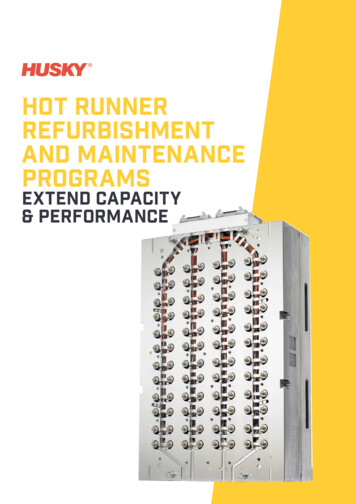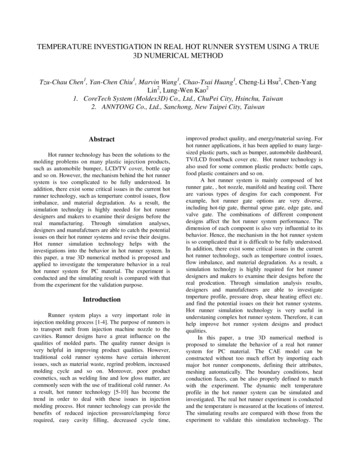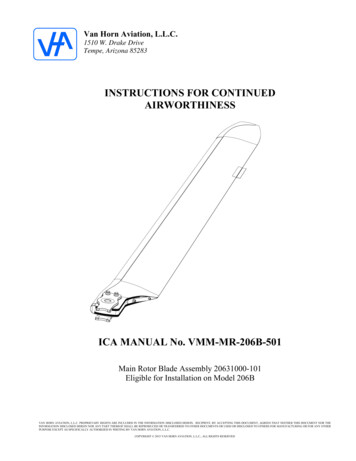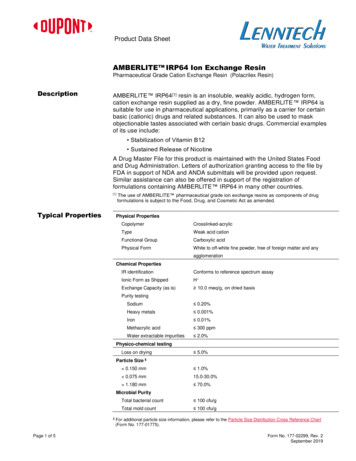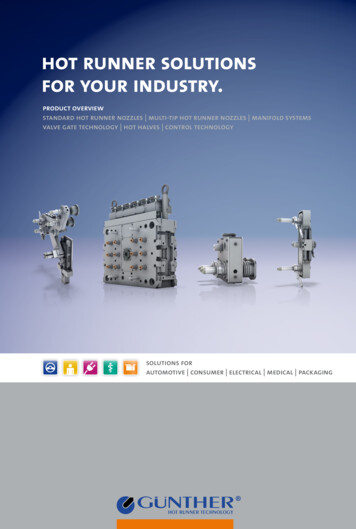
Transcription
Technical reference documentHot Runner ManualFor robust molding of semi-crystalline resinsIntroductionContentsMaximizing productivity is an important factor in determining part cost. One way toimprove productivity is using a hot runner system. The decision when to use a hotrunner system is mainly influenced by “yield” as hot runners can add complexity andcost to molds and require additional maintenance. Due to continuous improvementin the hot runner design a robust molding process is possible even with traditionallymore thermally sensitive thermoplastic resins.The hot runner design requirements for semi-crystalline polymers, such as DuPont Delrin (POM), DuPont Zytel (PA), DuPont Minlon (PA), DuPont Zytel HTN(PPA), DuPont Rynite (PET), DuPont Crastin (PBT), DuPont Sorona (PTT), andsome DuPont Hytrel (TPC-ET) differs from amorphous polymers in the way of theirsoftening, melting and freezing behaviors. Amorphous materials (like softer Hytrel grades) gradually soften with slowly decreasing viscosity from the solid state (Tg)to the processing temperature. This behavior provides a wide temperature range tocontrol viscosity when melting or freezing the resin.On the other hand, a semi-crystalline polymer becomes fluid with a relatively lowviscosity at a defined melting temperature (Tm). In the same way, a semi-crystallineresin freezes again at a defined freezing temperature, where noflow is possible. As a result, the processing window for the melting and freezingof semi-crystalline resins is relatively narrow, which needs to be considered whendesigning a hot runner system. This manual gives guidance on basic gate design andhot runner selection for the robust molding of semi-crystalline resins.Introduction11 Gate designs21.1 Indirect hot runner gating using cold sub runner 21.2 Direct hot runner gating of the part2 Hot runner selection222.1 Nozzle design22.1.1 Hot Runners with Open Nozzle or Torpedo32.1.2 Hot Runners with Valve Gates (Shut-off Nozzles) 43 Hot Runner Manifold44 Temperature distribution inside the Hot Runner 45 Temperature control of the cavity56 Temperature settings for DupontSemi-crystalline Resins67 Safety considerations61
1 Gate designsWhen using a hot runner system in a mold there are basicallytwo different gating scenarios possible: Indirect hot runner gating of the part using cold sub runners Direct hot runner gating of the partThe advantages and disadvantages of the different gatedesigns,as well as the preferred solution depending on resinchoice andpart design, are described in the following chapter.1.1 Indirect Hot Runner gating using a Cold Sub RunnerWhenever possible it is recommended to use a hot runnercombined with a cold sub runner when molding semicrystallineresins. This combination requires less precise thermal controlaround the nozzle tip and therefore contributes to a more robustprocess. With indirect gating, it is recommended to move thenozzle tip back from the parting line to avoid heat loss at thenozzle tip area once the tool is closed. Especially with partsrequiring a long hold pressure time and a good packing, indirectgating is highly recommended as the freezing time of a coldrunner is better to control versus a hot tip. For the cold subrunner, a cold slug trap in front of the hot tip should be providedto catch any frozen or degraded material, preventing it fromentering the cavity.Cold runner and gate designs should follow the guidelines forsemi-crystalline resins. It is recommended that the gate diameter(d) should be at least half of the wall thickness (T) of the part. Thediameter (D) of the tunnel next to the gate should be at least 1.2times the part thickness. The amorphous gate design shown onthe right side in Figure 1 is not recommended for semi-crystallineresins due to the risk of an early freezing and therefore aninsufficient hold pressure time. This can result in uncontrolledshrinkage that causes voids and/or sink marks, low mechanicalperformance, and dimensional problems.Figure 1: Indirect hot runner gating using a cold sub runner. Tunnel gate for semi-crystalline resins (left), tunnel gate for amorphousresins (right).1.2 Direct Hot Runner gating of the partIf it is requested to direct gate the part there are either nonself-insulating nozzle tip designs (see Figure 4) or self-insulatednozzle tip designs (see Figure 3) available. Whenever it ispossible, a hot runner nozzle with a non-selfinsulating nozzletip should be used. A non-self-insulating nozzle tip has lessrisk of material stagnation with improved maintenance in thecase of abrasion and corrosion. If the part is gated on a surfacewhich does not allow an exchangeable nozzle tip, a selfinsulating nozzle could be used. However, with a self-insulatingnozzle there is a higher risk of hold-up spots and thereforematerial degradation, as described in the next chapter.2 Hot Runner selection2.1 Nozzle DesignThere are two basic types of designs for hot runner nozzlesthat are widely used in injection molding: Open nozzle (includes also open nozzle with torpedo andinternally heated nozzles) Valve gate nozzle (shut-off nozzle)When molding semi-crystalline resins, the nozzle designshould allow a precise freezing and therefore a controlledseparation between molten material in the nozzle tip andfrozen material in the cavity. Poor nozzle design often leads tofreezing of the nozzle or to stringing and drooling and thus toproduction and quality issues. To avoid freezing of the nozzle tipduring mold opening or production stop, attention needs to begiven to the thermal insulation between the hot nozzle tip andthe mold. Insufficient thermal insulation between the nozzletip and mold generally leads to unacceptably high temperaturesettings of the hot runner and therefore to unacceptablematerial degradation.Design recommendations to meet the requirements, dependingon resin choice and part design, are described in the followingchapters.2
2.1.1 Hot Runners with Open Nozzle or TorpedoAn open nozzle design, as shown in Figure 2, offers goodflow properties and is often used when molding highly filledand abrasive materials. This design is not recommended forunreinforced materials as the freezing behavior of thosematerials limits precise separation of the bushing/runner andthe molten material at the nozzle tip. Thus, stringing in the gatearea occurs during mold opening. For an open nozzle design,as shown in Figure 2, it is recommended to always gate thepart by indirect gating, using a cold sub runner equipped witha cold slug trap (see Chapter 1.1). For highly filled resins, it isrecommended to use an exchangeable nozzle tip for the easeof maintenance.Figure 2: Open nozzle design with short bushing (left) and longbushing (right)Unlike the open nozzle, a system equipped with a torpedo issuitable for direct gating of the part. In general, for unreinforcedresins, an open nozzle design with torpedo avoids problemswith stringing and is recommended instead of using an opennozzle design without torpedo. However, for direct gating ofparts with high surface aspect requirements, there is a risk ofuncontrollable flow marks around the gate depending on thetorpedo design. Nozzles with a torpedo are less suitable forprocessing highly filled or flame-retardant resins due to theirflow restriction. Internally heated nozzles, as shown in Figure3, are not recommended for molding semi-crystalline resinsbecause of the risk of stagnation on hot steel surfaces. It is acommon practice to add a separate cooling circuit around thenozzle to be more independent from the mold temperature incontrolling the temperature around the nozzle and the nozzle tip.Not RecommendedNot RecommendedUnlike the open nozzle, a system equipped with a torpedois suitable for direct gating of the part. In general, forunreinforced resins, an open nozzle design with torpedo avoidsproblems with stringing and is recommended instead of usingan open nozzle design without torpedo. However, for directgating of parts with high surface aspect requirements, there isa risk of uncontrollable flow marks around the gate dependingon the torpedo design. Nozzles with a torpedo are less suitablefor processing highly filled or flame-retardant resins due totheir flow restriction. Internally heated nozzles, as shown inFigure 3, are not recommended for molding semi-crystallineresins because of the risk of stagnation on hot steel surfaces. Itis a common practice to add a separate cooling circuit aroundthe nozzle to be more independent from the mold temperaturein controlling the temperature around the nozzle and thenozzle tip.Unlike the open nozzle, a system equipped with a torpedois suitable for direct gating of the part. In general, forunreinforced resins, an open nozzle design with torpedo avoidsproblems with stringing and is recommended instead of usingan open nozzle design without torpedo. However, for directgating of parts with high surface aspect requirements, there isa risk of uncontrollable flow marks around the gate dependingon the torpedo design. Nozzles with a torpedo are less suitablefor processing highly filled or flame-retardant resins due totheir flow restriction. Internally heated nozzles, as shown inFigure 3, are not recommended for molding semi-crystallineresins because of the risk of stagnation on hot steel surfaces. Itis a common practice to add a separate cooling circuit aroundthe nozzle to be more independent from the mold temperaturein controlling the temperature around the nozzle and thenozzle tip.Whenever the nozzle tip is self-insulated by the molded resin,as shown in Figure 3, there is a high risk of stagnation andtherefore purging of degraded resin into the part. This leadsto material degradation, causing surface defects around thegating and black specks in the finished parts. To avoid thestagnation and hold-up spots, customers have good experienceusing Titanium or DuPont Vespel caps at the nozzle tip.Not RecommendedRecommendedFigure 3: Torpedo nozzle design, internally heated torpedo (a), torpedo with flow restriction (b), torpedo (c), torpedo with Titanium/Vespel cap (d)3
2.1.2 Hot Runners with Valve Gates (Shut-offNozzles)Hot runner systems with valve gates are more frequently usedfor the molding of precision parts made from semi-crystallineresins. Especially for multi-cavity tools with more than onenozzle it is strongly recommended to use a valve gate systemto ensure balanced filling of all cavities. Furthermore, whenmolding bigger parts where the pressure drop for filling is toohigh, a valve gated hot runner system with a selected numberof nozzles allows a segmented filling and stable packing byopening the valves in cascade. Depending on the nozzle designand the thermal insulation between nozzle and tool, a valvegated hot runner nozzle may lead to a limited hold pressuretime. This is due to an early freezing at the valve pin guidebefore achieving the sealing time of the part. In this case in thegating area often a cold deformation occurs once the needleis closing or a remaining pin is visible on the molded part. Ifthis happens the thermal insulation of the hot runner nozzleneeds to be improved to avoid part breakage in the gating areaas well as dimensional instability and an increased number ofvoids of the molded parts.Cylindrical guidance of the valve pin is always recommendedwhen molding semi-crystalline resins. With a conical shape,there is a high risk of deforming the sealing surface especiallywith reinforced resins. For thermally sensitive resins, which arecritical to hold up time, an adapted manifold design with animproved purging behavior is preferred (see Figure 4).AcceptableOptimumFigure 4: Valve gate design, standard manifold design (left),improved design minimizes stagnation (right)3 Hot Runner ManifoldIf there is more than one nozzle used in the tool, the melt istransported to the hot runner nozzles by the manifold system.In general, the channels of the manifold should be as smoothas possible to minimize melt sticking to the tool steel. To avoidcorrosion inside the hot runner a steel with a higher chromecontent is preferred.To achieve uniform filling of all cavities, it is recommended touse naturally balanced systems. All channel corners should beflow optimized to avoid hold-up spots and minimize pressuredrop in the manifold. Sharp corners in manifolds result inhigh shear stress, potential degradation of the material andincreased abrasion for reinforced resins. Hot runner suppliersoffer a wide range of flow optimized geometries.Not RecommendedFigure 5 shows channel corner designs which are availablefrom hot runner suppliers.The design shown in Figure 5 (a) is not suitable for moldingsemi-crystalline resins. In addition, the purging behavior is verylimited when changing the color or the material. An optimumflow design which minimizes shear, pressure drop and therisk of hold-up spots is shown in Figure 5 (c). This solution isthe most expensive but offers the best flow properties andpurging behavior. In Figure 5 (b) a compromise between designand cost of the hot runner is shown. However, this is notrecommended for molding optical parts and resins which arehighly reinforced and/or less thermally stable.AcceptableOptimumFigure 5: Manifold channel corner design4 Temperature Distribution inside the Hot RunnerTo achieve a stable and robust molding condition it isimportant that the temperature distribution inside the nozzleand the manifold is as uniform as possible. Therefore, whenassembling a hot runner system into a mold the gap betweennozzle, manifold and the tool needs to be well defined. A toonarrow gap leads to a heat loss of the hot runner system tothe tool by heat radiation. However, a too big gap leads to achimney effect and therefore also to an unacceptable heatloss of the hot runner system. At the supporting pins there isalways a higher heat transfer to the tool. To minimize the heattransfer it is recommended to use a material with low thermalconductivity.4
To achieve a temperature distribution as uniform as possibleat the manifold, it is strongly recommended that the manifoldis heated from both sides, as shown in Figure 5. Whenassembling a hot runner nozzle into the tool the contact areabetween tool and hot runner should be minimized to avoid afreezing of the nozzle due to an unacceptable heat transferfrom the nozzle tip to the mold, as shown in Figure 6. To assessthe performance, it is recommended to stop the process forfive minutes. If a startup after five minutes is possible usingrecommended melt temperature settings of the hot runnernozzle the thermal insulation is sufficient.If the nozzle is well assembled but it is difficult to controlits temperature setting, the location of the thermocoupleshould be checked. It is recommended that the location of thethermocouple is close to the nozzle tip, as shown in Figure 6.Also, it is important that the thermocouple is well connected tothe steel of the nozzle.Figure 6: Nozzle temperature gradient, large contact area wide temperature difference (left), good thermalisolation flat temperature profile (right)5 Temperature Control of the CavityCavity wall temperature uniformity canbe a challenge close to the hot runnernozzle. To control the temperaturearound the nozzle, it is recommendedto add separate cooling circuits aroundthe nozzle as shown in Figure 7. Forparts with high mechanical and opticalrequirements, it is always recommendedto use a cold sub runner to avoid defectsclose to the gate due to nonuniformcavity surface temperatures.Figure 7: Separated temperature control to achieve uniform mold surface temperature,indirect gating with cold sub-runner (left), hot runner direct gating (right)5
6 Temperature Settings for Dupont Semi-Crystalline ResinsIt is worth noting that a hot runner system does not contributeto the homogeneity of the melt. The task of a hot runner itselfis to transfer the melt to the cavity without significant heatloss. Therefore, it is not recommended to run a hot runner ata higher temperature than recommended to improve meltquality and/or reduce viscosity.Running a hot runner system above the recommendedtemperature may cause degradation of the resin. As a result,problems with surface defects and black specks as well asmold deposit increase dramatically. Table 1 shows an overviewof the recommended temperature settings for DuPont resins.Table 1: Recommended temperature settingsRecommendedtemperaturesetting screw/barrel [ C]Recommendedtemperaturesetting hotrunner [ C]190MaterialMaterial typeMelting point[ C]Delrin POM178215Zytel andMinlon PA66260290 – 295PA6220260 – 280Zytel HTNPPA295 – 310310 – 325Crastin PBT223250 – 260Rynite PET250285Hytrel TPC-ET152 – 221*180 – 250*As screw/barrel setting*: Melting point and recommended barrel temperature depend on Shore D hardness of the Hytrel resin.For most of the DuPont semi-crystalline resins, thetemperature in the hot runner system can be set accordingto the temperature recommendation for the barrel. The hotrunner temperature setting of Delrin acetal resin differs fromother DuPont semi-crystalline resins as the optimum barreltemperature is in many cases higher than the optimum hotrunner temperature. Delrin is sensitive to excessive heat andcan degrade if exposed for too long at high temperatures. Thelower temperature minimizes the heat exposure of the resinand is generally high enough to avoid freezing of the Delrin resin in the hot runner channel.Temperature settings shown in Table 1 are intended as an initialguideline. As hot runner systems can vary from case to case,adjustments may be necessary. The manifold temperatureshould be set according to Table 1. However, the temperatureof the hot runner nozzle should not exceed those temperaturesby more than 5 to 10 C.7 Safety ConsiderationsWhile processing thermoplastic resins, all potential hazardsmust be anticipated and either eliminated or guarded againstby following established industry procedures. Hazards mayinclude: Thermal burns resulting from exposure to hot moltenpolymer Fumes generated during drying, processing, and regrindoperationsSafety data sheets include such information as hazardouscomponents, health hazards, emergency and first aidprocedures, disposal procedures, and storage information.Refer to the specific product Molding Guide for moreinformation on safe handling.Note: Adequate ventilation and proper protective equipmentshould be used during all aspects of the molding process. Referto the DuPont Ventilation Guide for more detailed information. Formation of gaseous and liquid degradation productsNO WARRANTY - PLEASE READ CAREFULLYThe information set forth herein is furnished free of charge, is based on technical data that DuPont believes to be reliable, and represents typical values that fallwithin the normal range of properties. This information relates only to the specific material designated and may not be valid for such material used in combinationwith other materials or in other processes. It is intended for use by persons having technical skill, at their own discretion and risk. This information should not beused to establish specification limits nor used alone as the basis of design. Handling precaution information is given with the understanding that those using it willsatisfy themselves that their particular conditions of use present no health or safety hazards and comply with applicable law. Since conditions of product use anddisposal are outside our control, we make no warranties, express or implied, and assume no liability in connection with any use of this information. As with anyproduct, evaluation under end-use conditions prior to specification is essential. Nothing herein is to be taken as a license to operate or a recommendation toinfringe on patents.CAUTION: Do not use DuPont materials in medical applications involving implantation in the human body or contact with internal body fluids or tissues unless thematerial has been provided from DuPont under a written contract that is consistent with the DuPont policy regarding medical applications and expresslyacknowledges the contemplated use. For further information, please contact your DuPont representative.DuPont , the DuPont Oval Logo, and all trademarks and service marks denoted with , SM or are owned by affiliates of DuPont de Nemours, Inc. unlessotherwise noted.www.dupont.com/resins.html 2019 DuPont. All rights reserved.001-20208-PBU08196
1.1 Indirect hot runner gating using cold sub runner 2 1.2 Direct hot runner gating of the part 2 2 Hot runner selection 2 2.1 Nozzle design 2 2.1.1 Hot Runners with Open Nozzle or Torpedo 3 2.1.2 Hot Runners with Valve Gates (Shut-off Nozzles) 4 3 Hot Runner Manifold 4 4 Temperature distribution inside the Hot Runner 4


